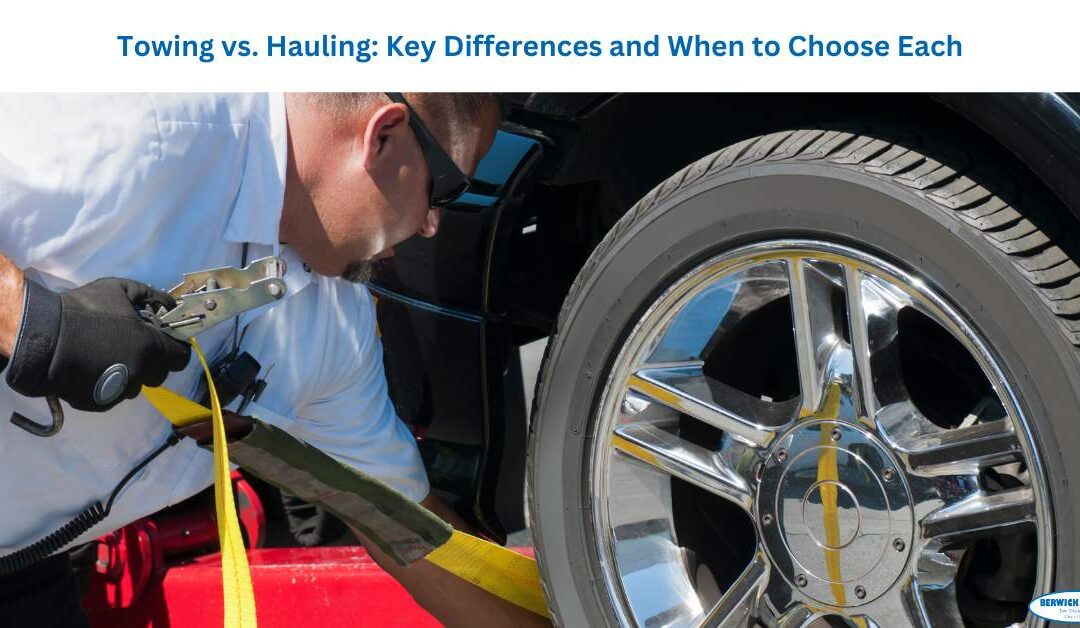When moving large, heavy loads, two common methods come to mind: towing and hauling. Though these terms are often used interchangeably, they have distinct differences and applications. Knowing when to choose towing or hauling can save time, effort, and ensure safety. Here’s a detailed look into both options, highlighting their key differences and when each method is best suited.
What is Towing?
Towing involves attaching a trailer or another vehicle to a towing vehicle, typically using a hitch or other towing connection. The vehicle providing the power pulls the load behind it, relying on the towing hitch, frame, and towing capacity of the main vehicle.
Common Uses for Towing:
Transporting vehicles (cars, motorcycles, boats, or RVs)
Moving small to medium-sized trailers (e.g., camping trailers, small utility trailers)
Emergency services for disabled vehicles, especially by tow trucks
What is Hauling?
Hauling refers to carrying or transporting a load within the vehicle itself. The load is either placed in the bed (for trucks) or stored securely within the cargo area of a van, SUV, or other large vehicle. In hauling, the weight is borne directly by the vehicle and is not attached externally.
Common Uses for Hauling:
Moving construction materials (e.g., wood, bricks, gravel)
Transporting large equipment or machinery
Carrying bulk loads (furniture, appliances) within a truck bed or cargo area
Key Differences Between Towing and Hauling
Load Placement and Capacity
Towing: The load is positioned behind the vehicle, allowing for easy detachment. Towing capacity depends on the vehicle’s engine power, frame strength, and hitch rating.
Hauling: The load is placed on or within the vehicle. Hauling capacity is determined by the payload rating of the vehicle, considering both the weight it can carry in the bed and the vehicle’s gross vehicle weight rating (GVWR).
Vehicle Requirements
Towing: Any vehicle with adequate towing capacity and a hitch can tow. Trucks and SUVs are commonly equipped for towing, though some smaller vehicles with suitable hitches can tow lighter loads.
Hauling: Vehicles with a large bed or cargo area, such as pickup trucks, vans, or specialized haulers, are ideal for hauling. Hauling requires a sturdy build to support the entire load within or on the vehicle.
Speed and Maneuverability
Towing: Towing can restrict vehicle maneuverability, especially with large trailers. Towed loads can swing or fishtail if not balanced properly, making turns and lane changes challenging.
Hauling: Hauling allows for more control and maneuverability since the load is within the vehicle. Hauling is generally safer at higher speeds compared to towing, provided the load is secure and within weight limits.
Fuel Efficiency
Towing: Towing a load often decreases fuel efficiency more drastically because the engine has to work harder to pull additional weight and deal with aerodynamic drag.
Hauling: Hauling tends to impact fuel efficiency less since the load is directly on or in the vehicle. However, heavier loads will still lower fuel efficiency.
Safety Concerns
Towing: Extra care is needed to secure the connection between the vehicle and trailer. Proper hitching, load balancing, and using safety chains are essential for safe towing.
Hauling: Safety involves ensuring the load is evenly distributed and secured within the vehicle, preventing shifting during transit.
When to Choose Towing
Choose towing if:
You need to transport a vehicle. Towing is ideal for moving disabled or non-operational cars, motorcycles, boats, or RVs.
Your load exceeds your vehicle’s hauling capacity. Heavy loads often require towing with a strong trailer, allowing more weight to be moved without overloading the vehicle itself.
You want to detach the load easily. Towing offers flexibility in dropping off trailers or other vehicles, which can be more efficient than unloading a vehicle entirely.
When to Choose Hauling
Choose hauling if:
Your load fits within the bed or cargo area of your vehicle. Hauling is practical for transporting materials or equipment in smaller, contained spaces.
You need better control and maneuverability. Hauling allows for improved control, especially useful when navigating tight spaces or city driving.
You’re concerned about fuel efficiency. Hauling generally offers better fuel efficiency for lighter loads that can be directly supported by the vehicle.
Choosing the Right Option: Factors to Consider
When deciding between towing and hauling, assess these key factors:
Load Type and Size: Large, bulky items that won’t fit into a truck bed are better suited for towing, while contained items are ideal for hauling.
Distance and Terrain: For long-distance travel, towing can be more comfortable, especially if it’s a large load. However, hauling might be preferred in rough terrain, where stability and control are crucial.
Vehicle Capabilities: Check your vehicle’s towing and payload capacities. Overloading can damage the vehicle, reduce safety, and lead to mechanical issues.
Safety Requirements: Both methods have specific safety concerns. Ensure that you have the necessary equipment for towing (hitch, chains) or securing hauled loads (straps, anchors).
Conclusion
Both towing and hauling are effective ways to transport heavy loads, but each has its unique strengths. Towing is ideal for moving large, uncontained loads like vehicles or oversized items, while hauling works best for loads that can fit directly within the vehicle. Understanding these differences can help you make the best choice for your needs, enhancing safety, efficiency, and fuel savings on the road.
If you are in Lysterfield South, Victoria 3156, Australia, and looking for a car removal service, this is the best way to visit us.
Contact Us
Berwick Towing & Transport
27B William Rd
Berwick VIC 3806
(03) 7035 7815
www..berwick-towing.com.au/

